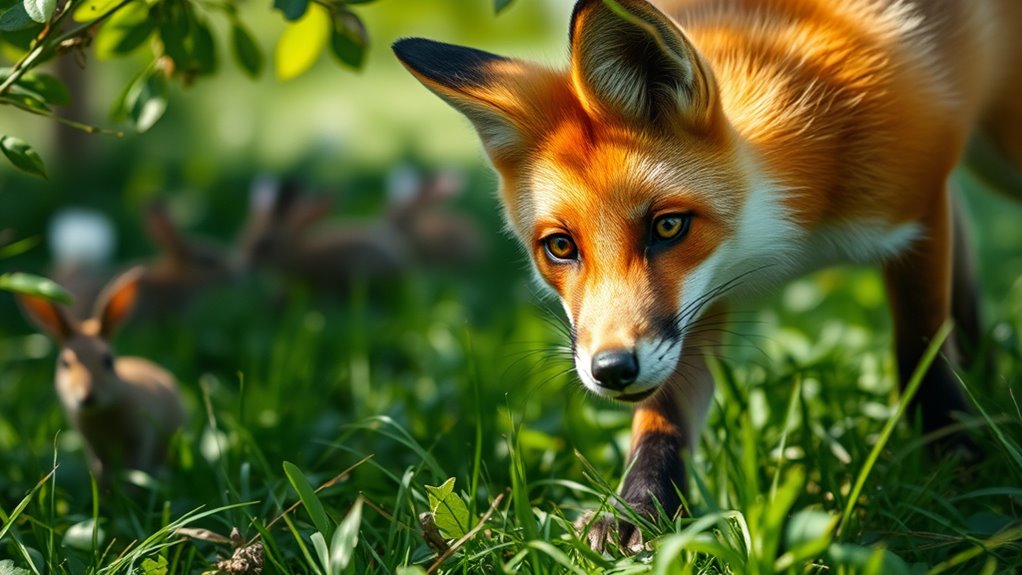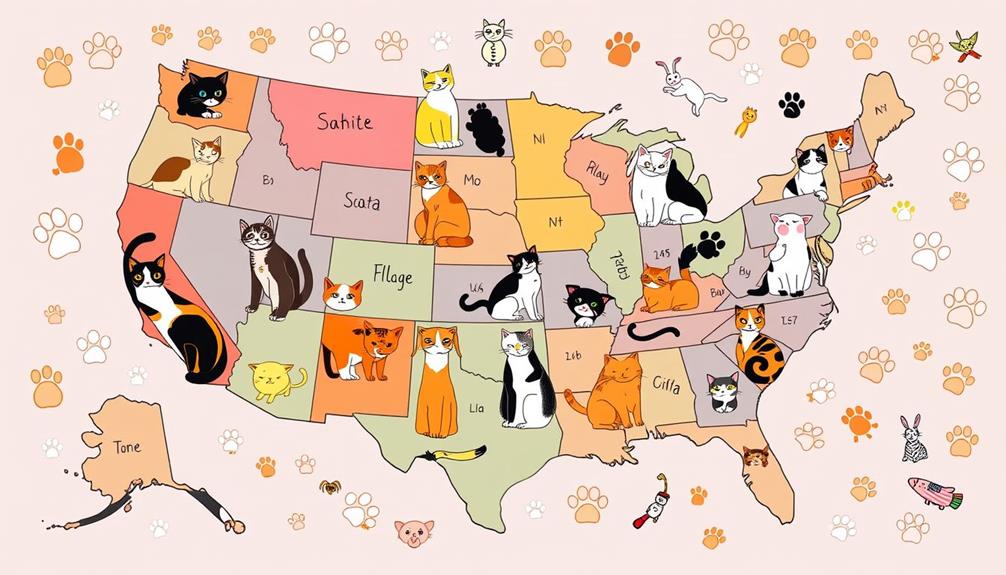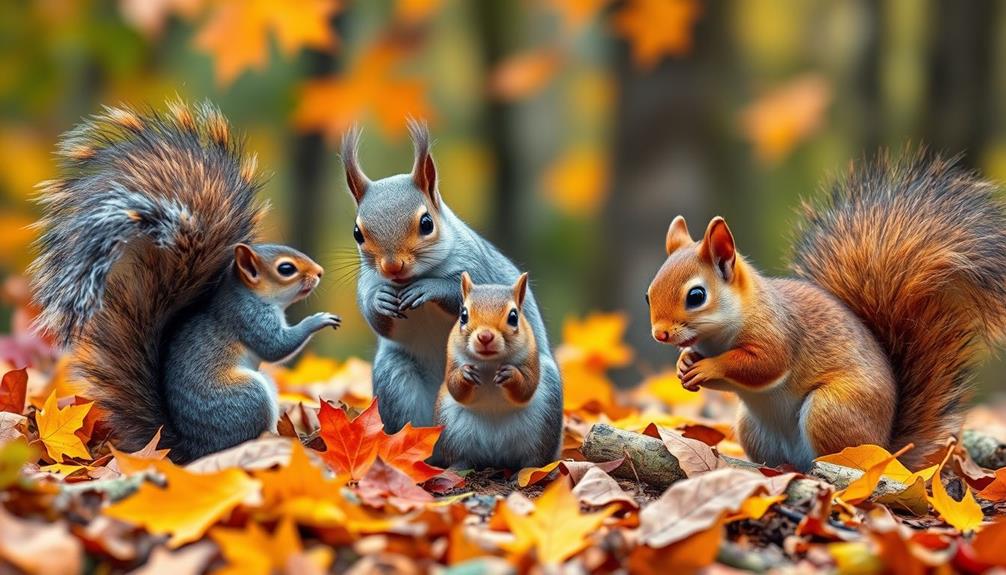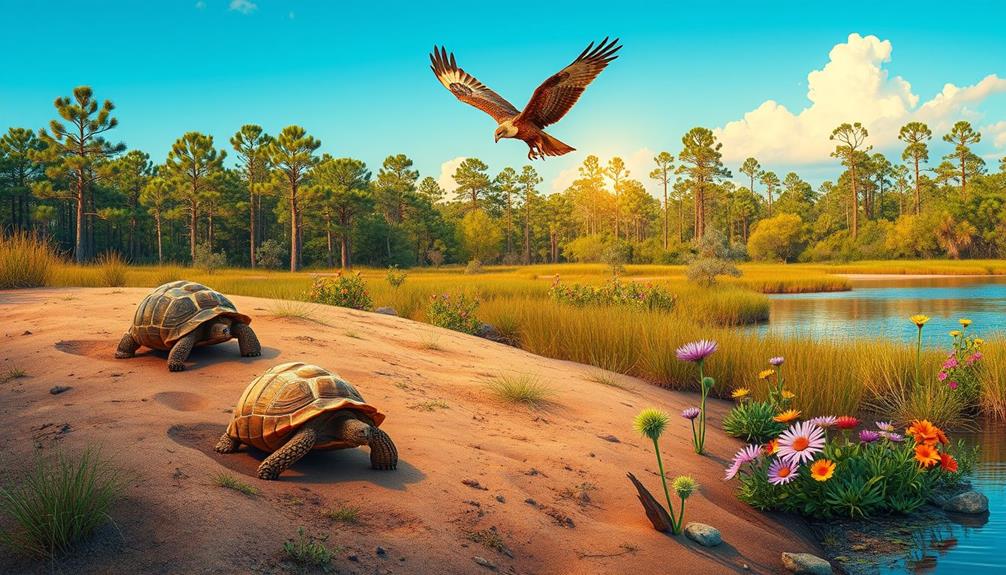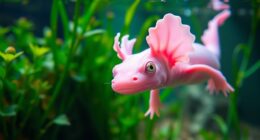Animal instincts are fascinating, inborn behaviors that drive survival and reproduction. They're hardwired into the DNA of species and manifest through fixed action patterns. Instincts help animals hunt, escape predators, and reproduce, all essential for species continuation. Hormonal influences and biological wiring play key roles in triggering these behaviors. While humans also have instincts guiding actions and emotions, the complexity of human instincts differs from those in the animal kingdom. Discover more intriguing aspects of instincts and their impacts.
Key Takeaways
- Instincts are inborn behaviors essential for survival, driven by biological factors, and encoded in an organism's DNA.
- Fixed Action Patterns (FAPs) demonstrate that instincts can occur automatically without prior learning or experience.
- Instinctual behaviors, like feeding and predator evasion, have evolved through natural selection to optimize survival and reproduction.
- Hormonal influences and brain structures, such as the hypothalamus, regulate and trigger various instinctual behaviors in animals.
- Human instincts exhibit complexity through social and emotional influences, distinguishing them from simpler animal instincts.
What Are Instincts?

Instincts are fascinating inborn behaviors that play a vital role in survival and reproduction. These complex patterns of behavior are automatic and driven by biological factors rather than learned experiences. Unlike reflexes, which are simpler responses to stimuli, instincts are ingrained within your genetic makeup. They're programmed into your DNA, ensuring automatic responses that help you navigate life. While instincts can be shaped by experience, they remain fundamentally innate, essential for the survival of your species. As you observe different animals, you'll notice how instincts manifest, like sea turtles heading to the ocean after hatching or birds migrating thousands of miles. These behaviors have evolved through natural selection, optimizing survival and adaptation across generations. Fixed action patterns are a prime example of how instinctual behaviors occur without prior experience or learning.
Types of Instinctual Behaviors

Understanding the various types of instinctual behaviors reveals how animals interact with their environment and secure their survival. These behaviors can be categorized into several types, each playing a significant role in their lives.
| Type of Behavior | Description |
|---|---|
| Feeding Instincts | Involves innate behaviors for hunting or foraging. |
| Predator Evasion | Helps animals avoid danger through camouflage or flight. |
| Reproduction Instincts | Mating rituals guarantee species continuation. |
| Nesting and Shelter | Guides animals in building nests for protection. |
| Migration Patterns | Seasonal movements driven by instinct for survival. |
These instinctual behaviors illustrate the remarkable adaptations animals have developed to thrive in diverse environments. For example, baby snakes instinctively know how to hunt without parental care after hatching, relying on pre-installed instincts encoded in DNA for survival. Additionally, understanding these behaviors can enhance our emergency preparedness essentials by allowing us to learn from nature's strategies for survival.
The Role of Instincts in Survival

While animals face numerous challenges in their environments, their survival often hinges on instinctual behaviors that guide their actions.
You might notice how birds migrate to find food or how beavers instinctively build dams for shelter. Instincts also play a vital role in evading predators; for example, the electric eel uses its electric shock defense effectively. Animals, like lions, also rely on inherited patterns to acquire food, showcasing behaviors driven by instinct. These behaviors aren't just random; they're inherited patterns that have evolved over time to provide a survival advantage.
Human Instincts: A Closer Look

Animals rely on instinctual behaviors for survival, and humans aren't any different when it comes to traversing their environment. You experience various instincts that guide your actions every day.
Fear keeps you alert to potential dangers, while your caring nature fosters strong bonds with family and friends. The drive for pleasure and lust influences your romantic pursuits, and the instinct to play brings joy across all ages. In fact, these instincts, particularly primitive yet powerful responses, highlight the importance of innate behaviors.
Fear sharpens your awareness, while love strengthens your connections; desire fuels romance, and playfulness brings happiness to all.
Self-preservation kicks in during threats, ensuring your survival. Basic needs like hunger and thirst remind you to nourish yourself, while the urge to sleep restores your health.
Finally, your curiosity and empathy push you to explore and connect with others, shaping your social and emotional experiences throughout life.
Mechanisms Behind Instincts

Understanding the mechanisms behind instincts reveals how deep biological wiring influences behavior. You'll see how specific stimuli trigger instinctual responses and the role hormones play in modulating these reactions. These instinctual behaviors, shaped by evolutionary history, ensure species survival and adaptation to their environments.
Biological Wiring of Instincts
Instincts arise from intricate biological wiring that involves genetic, hormonal, and neural mechanisms. You inherit these patterns of behavior through generations, shaped by genetic factors.
Neuroactive chemicals, like neuropeptides, regulate specific behaviors; for instance, angiotensin II triggers drinking in vertebrates. Key brain structures, such as the hypothalamus and pituitary glands, control hormonal responses linked to these instinctual behaviors.
Instincts also evolve through natural selection, enhancing survival and reproduction. Environmental factors can induce epigenetic changes, further influencing behaviors across generations.
Fixed action patterns (FAPs) manifest as consistent, innate responses, while innate releasing mechanisms (IRMs) activate these behaviors in response to particular stimuli. Simple instincts are essential for immediate survival, highlighting the fundamental aspects of instinctive behavior. Together, these elements create a complex network that governs your instincts.
Stimuli Triggering Instinctual Responses
When specific stimuli hit your senses, they can trigger instinctual responses that are hardwired into your biology. These sign stimuli, like a red mark on a gull's beak or the presence of a female sage grouse, activate fixed action patterns (FAPs) essential for survival. Fixed action patterns are highly stereotyped and species-characteristic behaviors that run to completion once triggered.
Even single attributes can initiate these responses, which can be exploited by other species—think of brood parasitism. Supernormal stimuli, such as larger eggs, provoke stronger reactions than natural cues, sometimes leading to maladaptive behaviors, like overinvesting in parasitic chicks.
Releasers, whether visual or chemical, also play a key role in instinctive behavior, ensuring that your reactions are swift and effective, enhancing your chances of survival in an ever-changing environment.
Role of Hormones
Hormones considerably shape your behavior, particularly during critical life stages like reproduction and parenting. They influence instincts by modulating the likelihood of specific actions in response to environmental cues. For instance, seasonal changes trigger hormonal fluctuations that drive migratory and mating behaviors. Hormones like estrogen and testosterone are crucial for courtship and nurturing activities. Their effects are complex, acting on your brain's neural circuits, and are influenced by genetic and developmental factors. During early development, hormones organize future behaviors, while in adulthood, they activate temporary responses. Social interactions also affect hormonal balances, altering behaviors such as nesting. Notably, hormonal influences can impact anatomical and neural characteristics during fetal stages, further shaping future behaviors.
Ultimately, hormones help you adapt your instincts to both internal and external demands.
Evolutionary Perspectives on Instincts

When you look at instincts through an evolutionary lens, you'll see how essential they're for survival and reproduction. These behaviors have adapted over time, shaped by environmental pressures that favor specific traits. Understanding these adaptations can illuminate the complex ways animals respond to their surroundings. Ethology emphasizes direct observation of various animal species in their natural environments, providing insight into the evolution of these instincts.
Survival and Reproduction
Instincts play an essential role in the survival and reproduction of animals, guiding them through behaviors that have evolved over millions of years. These instincts guarantee that animals react promptly to threats and engage in essential reproductive activities.
Here are three key aspects of these instincts:
- Genetic Basis: Survival instincts are inherited and present at birth, enabling quick reactions to dangers.
- Innate Reproductive Behaviors: Animals perform specific courtship rituals and parental care, vital for species continuity. Self-preservation drives these behaviors, ensuring that offspring are cared for and protected.
- Adaptation and Evolution: Instincts evolve through natural selection, optimizing behaviors for survival and reproductive success in various environments.
Environmental Adaptations
Survival and reproduction hinge on how well animals adapt to their environments, reflecting the intricate relationship between instinct and adaptation. Animals exhibit both behavioral and physiological adaptations that enhance their survival. For instance, migration patterns help species find resources, while social structures promote cooperation. Physical adaptations like the long necks of giraffes are also critical for reducing competition for food in their habitats.
| Type of Adaptation | Examples |
|---|---|
| Behavioral Adaptations | Nest-building in birds |
| Physiological Adaptations | Camels managing water in deserts |
| Evolutionary Drivers | Natural selection shaping traits |
These adaptations are shaped by environmental pressures and genetic variations over time. Learning behaviors can become instinctive, ensuring future generations thrive in their habitats. Understanding these adaptations is essential for conservation efforts in a rapidly changing world.
Instincts vs. Learned Behaviors

While both instincts and learned behaviors are essential for animal life, they represent different approaches to survival. Instincts are inherited behaviors, hardwired from birth, vital for immediate responses to threats. In contrast, learned behaviors develop over time through interactions and experiences.
Here's a quick comparison:
- Instincts: Fixed action patterns like courtship rituals and predator evasion are essential for survival, passed down through generations.
- Learned Behaviors: These behaviors, such as foraging techniques in dolphins, adapt based on environmental cues and social interactions. Dolphins learn hunting strategies from pod members, enhancing their success in acquiring food.
- Role in Survival: Instincts address basic survival needs, while learned behaviors allow for innovation and adaptation to new challenges.
Understanding the balance between these behaviors helps clarify how animals thrive in diverse environments.
The Impact of Hormones on Instinctual Actions
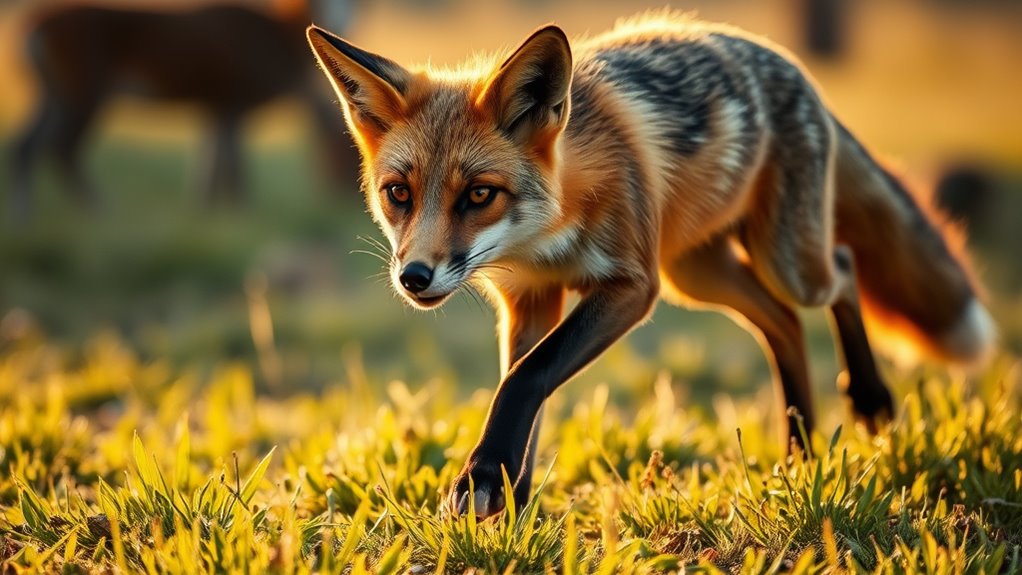
Hormones play a crucial role in shaping instinctual actions among animals, influencing everything from courtship to migration. For instance, estrogen and progesterone drive courtship behaviors in species like the ring dove, while testosterone heightens aggression during breeding seasons. Communication signals are also essential during this time, as animals produce various sounds and displays to attract mates and deter rivals.
Seasonal changes trigger hormonal shifts, guiding migratory instincts in birds by responding to environmental cues like daylight and temperature. These hormones also affect neural development, which shapes adult behaviors.
Parenting instincts, influenced by prolactin, kick in as environmental factors and social interactions alter hormonal balances. Consequently, hormones not only dictate individual behaviors but also guarantee species survival through instinctual actions, highlighting their significant impact on animal life.
Exploring Instincts Through Education and Activities
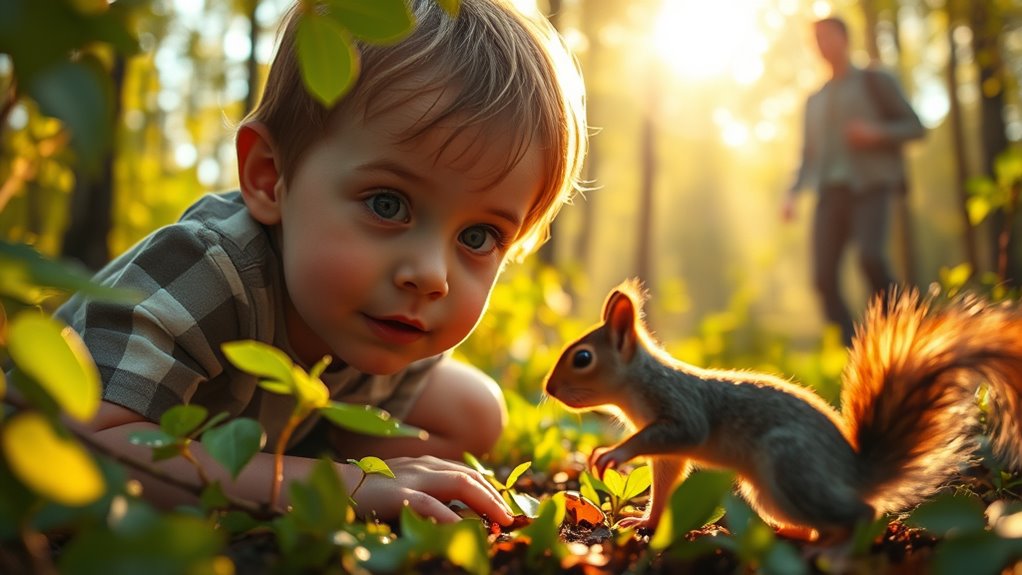
Understanding animal instincts can be an engaging and enriching experience when you incorporate various educational activities. These activities not only enhance your knowledge but also deepen your appreciation for the complexities of animal behavior. Here are three effective methods to explore instincts:
Exploring animal instincts through educational activities can enhance your understanding and appreciation of their fascinating behaviors.
- Observation Exercises: Spend time in natural habitats observing animals. This firsthand experience will help you identify instinctual behaviors.
- Gallery Walk Activity: View images of animal behaviors and discuss whether they're instinctual or learned. This promotes critical thinking and collaboration.
- Role-Playing: Act out different animal behaviors to grasp the concept of instincts in a fun, interactive way. Engaging in instinctual behaviors can also help reinforce the understanding of how these innate actions function in the wild.
Frequently Asked Questions
Can Instincts Change Over an Animal's Lifetime?
Yes, instincts can change over your lifetime. As you interact with your environment, experiences shape your behaviors, blending instinctual responses with learned behaviors.
For instance, when faced with new challenges, you might adapt your instincts to improve survival. Epigenetic factors also play a role, allowing your instincts to evolve based on environmental influences.
This dynamic interplay means that instincts aren't static; they can transform throughout your life, enhancing your adaptability.
Are Instincts the Same in All Animal Species?
You might think all animals share the same instincts, but that's far from the truth. Each species has evolved unique instincts tailored to their survival needs.
For instance, while birds migrate thousands of miles, a shark's instinct helps it detect blood from afar. These diverse instincts reflect the beauty of evolution, showcasing how life adapts in fascinating ways.
How Do Instincts Differ From Learned Behaviors?
Instincts are innate behaviors you're born with, essential for survival, like fleeing from danger or seeking food. They don't require learning or experience; they're hardwired into your genetics.
On the other hand, learned behaviors develop through interaction with your environment and experiences. For instance, you might learn to find food through observation.
While instincts guarantee immediate survival, learned behaviors help you adapt to changing situations over time.
Can Instincts Be Influenced by Environmental Changes?
Instincts are like rivers, flowing and reshaping with the landscape around them. Yes, instincts can definitely be influenced by environmental changes.
When habitats shift or resources dwindle, you'll notice animals adapting their behaviors to survive. These modifications can be immediate or gradual, and sometimes they even pass down through generations.
As the environment shifts, instincts aren't static; they evolve, reflecting the pressures and opportunities of their surroundings.
What Role Do Genetics Play in Forming Instincts?
Genetics play an essential role in forming instincts. Your genetic makeup determines specific unlearned behaviors that are passed down through generations. These inherited traits help guarantee survival and are often triggered by particular stimuli.
While instincts are largely innate, they can also be influenced by environmental factors, creating a complex interaction between genetics and surroundings. This means your instincts might adapt over time, reflecting both your genetic history and experiences.
Conclusion
In exploring the mystery of animal instincts, you've seen how these innate behaviors shape survival and adaptation. From the way a bird builds its nest to the fight-or-flight response in humans, instincts play an essential role in our lives. But have you ever considered how much of your own behavior is driven by instinct versus learned experiences? By understanding these primal forces, you can gain a deeper appreciation for the intricate dance between nature and nurture in both animals and yourself.
